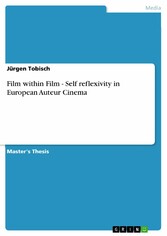Search and Find
Service
Film within Film - Self reflexivity in European Auteur Cinema
Master's Thesis from the year 2003 in the subject Film Science, grade: 1,0, University of Edinburgh, language: English, abstract: Wim Wenders, one of the key figures of New German Cinema, a movement similar to the 'Nouvelle Vague' in some ways, is of another generation than Fellini and Godard. In his film 'Der Stand der Dinge' (1982) he literally commutes between the two poles of his filmmaking, Europe and the US. The film begins in Portugal, where a film crew is forced to stop shooting and ends at the place where all the great cinema myths arise, Hollywood. Wenders' film is an attempt by a young filmmaker to find a stable creative position in unstable times. (Wenders had just experienced great difficulties in making 'Hammett' (1982) in the US). In 'Der Stand der Dinge' this is exemplified by the direct inclusion of his own thoughts about European and American filmmaking, images and stories, and black-andwhite and colour film stock, opposites that are not harmoniously resolved at the end. Among the three films discussed Wenders' film within the film is the only one not completed, suggesting an unsure future for the cinema. In examining these three films, I shall focus on the following aspects: 6 • In what way does the film reflect on the history of motion pictures (references to it)? • What attitude does the filmmaker have concerning the artificial-illusionist elements of his profession/product? • How does the filmmaker deal with the narrative and filmic conventions of his profession? • What does the film tell us about the film director's artistic and working style. Does 'life imitates art' in these films? • To which extent can autobiographic elements be found in these films and can any parallels between the director in the film and the director of the film be drawn? • How can the film be classified in the oeuvre of the director? Does it mark the end of one phase of his work and/or lead into a new one? • How is the 'film within the film' plot accomplished? Finally, all three films will be compared with each other with regard to the above mentioned questions which will then lead to a final assessment of the self-reflexivity , explored in these films. [...]
All prices incl. VAT













